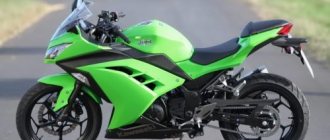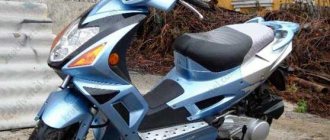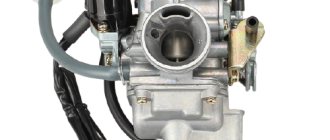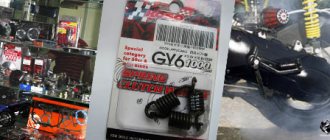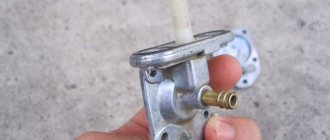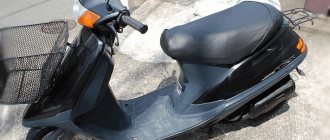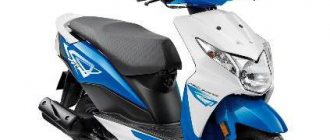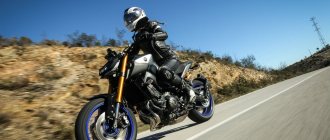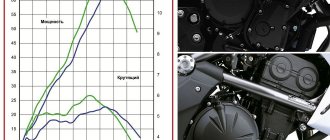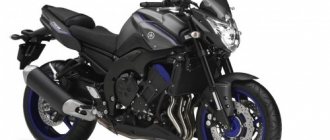| Yamaha NIKEN (2019+) | Yamaha NIKEN GT (2019+) |
Sports-touring model Yamaha NIKEN
was first presented in 2021 at the Tokyo Motor Show, and official sales started in September 2021 (model year 2019).
The model is distinguished by a unique concept, which is based on the use of two front wheels and the proprietary LMW (Leaning Multi Wheel) system, which allows a three-wheeled motorcycle to gain the controllability of a two-wheeled one. Before the advent of the NIKEN model, similar technologies were used in the Yamaha Tricity scooter.
The Yamaha NIKEN was based on the engine from the MT-09 series - an in-line 3-cylinder liquid-cooled unit with a volume of 847 cm³ and producing 115 hp. power and almost 88 Nm of torque.
The motorcycle frame is a structure made of steel pipes with aluminum elements, in particular the swingarm. The front suspension is a combination of two inverted telescopic forks on each wheel, fully adjustable. The LMW system achieves the effect of a fully independent front suspension, providing optimal traction in almost all conditions and in all weathers.
In parallel with the regular NIKEN version, the NIKEN GT is offered on the market. This modification is distinguished by high touring glass, a more comfortable saddle, heated hands, side panniers, a luggage rack, two 12V sockets and a central stand.
NIKEN series models are also equipped with all modern Yamaha electronic technologies:
- Electronic throttle (YCC-T - Yamaha Chip Controlled Throttle)
- ABS
- Cruise control
- Traction control system (TCS - Traction Control System)
- Selectable D-Mode
- Quick shifter (QSS - Quick Shift System)
- Assist and Slipper clutch
Specifications
Yamaha NIKEN Specifications:
| Model | Yamaha NIKEN |
| Motorcycle type | sports-tourist |
| Year of issue | 2019+ |
| Frame | Hybrid (steel pipes, aluminum swingarm) |
| engine's type | 3-cylinder, 4-stroke, in-line |
| Working volume | 847 cm³ |
| Bore/Stroke | 78.0 x 59.1 mm |
| Compression ratio | 11.5:1 |
| Cooling | liquid |
| Number of valves per cylinder | DOHC, 4 valves per cylinder |
| Fuel supply system | Injector with YCC-T (Yamaha Chip Controlled Throttle), 3x 41 mm |
| Ignition type | TCI |
| Maximum power | 115.0 hp (84.6 kW) at 10,000 rpm D-Mode TCS (Traction Control System) Cruise Control System |
| Maximum torque | 87.5 Nm (8.8 kg-m) at 8500 rpm |
| Clutch | Multi-disc in oil bath, cable drive |
| Transmission | 6-speed QSS (Quick Shift System) |
| type of drive | chain |
| Front tire size | 2x 120/70-R15 M/C (56V) |
| Rear tire size | 190/55-R17 M/C (75V) |
| Front brakes | 2 discs, 298 mm, 4-piston radial calipers (ABS) |
| Rear brakes | 1 disc, 282 mm, 2-piston caliper (ABS) |
| Front suspension | 2x 43/41 mm inverted fork (LMW system - Leaning Multi Wheel) (fully adjustable), travel - 110 mm |
| Rear suspension | Pendulum with monoshock absorber (fully adjustable), stroke - 125 mm |
| Motorcycle length | 2150 mm |
| Motorcycle width | 885 mm |
| Motorcycle height | 1250 mm – NIKEN 1425 mm – NIKEN GT |
| Wheelbase | 1510 mm |
| Seat height | 820 mm – NIKEN 835 mm – NIKEN GT |
| Minimum ground clearance (clearance) | 150 mm |
| Acceleration 0-100 km/h (0-60 mph) | 3.42 sec[1] |
| Maximum speed | 219 km/h[2] |
| Gas tank capacity | 18.0 l (including reserve - 4.0 l) |
| Motorcycle weight (curb) | 263.0 kg – NIKEN 267.0 kg – NIKEN GT |
Three-wheel scooter Yamaha Tricity 300
I'll start from afar: I ride tricycles. At one time I had a Japanese three-wheeled Poltishok, there was an Italian inclined tricycle, then another one appeared. I love this technology with all my heart, I’m ready to talk about it for hours, and probably wake me up in the middle of the night and ask me to name all the current models of inclined trikes - I’ll list them.
Of course, I didn’t just memorize their names, but also read reviews, followed the market, monitored advertisements, and I was always curious to ride analogues of my Italian. Among several other models was the Japanese baby Tricity 125, which Yamaha lovingly calls LMW - Leaning Multi Wheel, that is, an inclined multi-wheeled vehicle. Synthetic is such an abbreviation: it essentially means a separate class of equipment produced by one specific manufacturer. Then they got the great and terrible Niken, which I honestly tried to beg for a test from the dealer, but they quite politely explained to me that they wouldn’t be given a separate copy for a test drive, and a used motorcycle with us is sharply cheaper, and that’s for them it will be unprofitable. Niken, by the way, was released in two versions, one in the GT version (which is traditionally understood as Granturismo), and the second in the urban segment.
And recently this segment was replenished with another model. Apparently, the Japanese have allocated an additional budget for promotional companies, because they called me from the dealership and made me very happy. It turned out that the Yamaha Tricity 300, a new reclining three-wheeled maxi-scooter, was going to be given to me for a test ride for review.
They asked me to mention in the article that I am not obligated to buy it if I hand it over safe and sound - so I mention it
Leaning three-wheelers in general, and the Yamaha Tricity three-wheeler in particular, are designed with one single purpose: to add support to the front suspension. This useful reserve of rubber grip solves most of the problems that a motorcyclist faces when riding on rough asphalt. Well, in the sense that when the asphalt is normal, smooth, clean and even, the usual layout is enough. When we are not afraid to put the motorcycle into a turn, knowing that everything is clean and smooth in the turn, there is no need for a third wheel.
Three-wheel scooter Yamaha Tricity 300
But when you are in the city in the pouring rain, you turn right from bitumen patches over the rails, and a brutal minibus is pressing behind you, not realizing that all these patches, holes, hatches and rails in the rain can lead you, a motorcyclist, straight under its wheels , you really understand why a complex and heavy front suspension is needed at all. It saves your skin exactly in those situations where a regular, single, front wheel can break off - on slippery, inclined surfaces, driving at the wrong angle and other critical driving errors. Unfortunately, we cannot always influence the road and fellow travelers - and we can only rely on what we can influence - the supply of a life-saving grip.
Yamaha Tricity 300 suspension
I described the front suspension of the Yamaha Tricity 300 as complex and heavy. Yes, this is an inevitable feature of any inclined three-wheeler. Let's start with the fact that there are two wheels in front, and each one needs a shock absorber, at least a cantilever one-way fork. In the case of Tricity, everything is even more fun - the front wheel forks are really single-sided, but each has two stays on the inside of the wheels. Each of these forks has its own axle, driven by a lever from a common steering column, and all this is installed in a parallelogram suspension that firmly holds both steering columns, synchronizing their position relative to the frame so that the motorcycle tilts as naturally as possible, without the application of additional effort and without separation outer wheel from the surface. At the same time, the design of the parallelogram suspension itself allows you to smooth out unevenness: if only one wheel passes over an unevenness, then it rises slightly, and the motorcycle frame (and the steering wheel, of course) does not change its orientation in space. This design provides very responsive steering, combining easy wheel turning using the steering wheel at low speeds, traditional counter-steering and high responsiveness to weight transfer. And all this - against the backdrop of confident grip on the road, because usually only one front wheel breaks off on uneven surfaces, while the second one retains grip on the road and protects it from lateral slipping. The ground clearance of the three-wheeled scooter is 130 mm, and this is quite enough for the tasks facing the Yamaha Tricity 300.
And the tasks facing the Yamaha Tricity 300 suspension are quite simple and unpretentious: ride on the roads without problems, having large reserves of grip and braking force on the front axle. Yes, two front wheels are not only an opportunity not to slip when passing obstacles, not only more powerful braking, but also more modulated. This means that using the front brake when cornering, even sharply in case of unexpected danger, does not threaten an immediate fall. The wide track (470 mm) and stability on the trajectory when turning and steering make this device ideal for beginners, including those who have already had experience in owning a two-wheeled city scooter. The wheelbase of 1595 millimeters makes it both maneuverable and stable, and the weight distribution along the axles is 50:50 - this means that its chassis is perfectly balanced, without a tendency to unexpected dives or, on the contrary, lifting the front.
Three-wheel scooter Yamaha Tricity 300 2020
Design of the three-wheeled scooter Yamaha Tricity 300
The new frame is made of small-diameter tubes that are lightweight and durable, and in the area of the steering column they are reinforced with sheet inserts for precise and responsive steering. To reduce vibrations, the engine is mounted through a linkage system, which makes the ride smoother and more comfortable.
The new Tricity is designed quite recognizable. Here it is worth recognizing that Yamaha was limited by rigid boundaries: on the one hand, it is difficult to come up with something truly unique in the design of the scooter, and on the other hand, the wide front suspension and two wheels suggest a certain “beak” shape. So Yamaha took the design of its MAX series sports scooters, added a little bit of another NIKEN three-wheeler - and put it on a wide front suspension.
They made the front fairing somewhat more compact than that of other three-wheelers. The short and relatively narrow nose of the Yamaha Tricity 300 offers curious eyes an overview of the operation of the unusual suspension. The sleek, layered fairing design echoes the front fenders, which hug the large front wheels with wide tires. True, there is also a drawback: if the three-wheeled Piaggio scooters, in particular the mp3 series models, with which we ultimately compare the Yamaha Tricity 300, the radiator of the water cooling system is located in the “muzzle,” then the Japanese one is behind the front wheels, and Accordingly, all the splashes from the wheels are his.
Unlike competitors in the 300cc class that have small front wheels, the Yamaha Tricity 300 three-wheeler is equipped with 14-inch wheels both front and rear, combining visual balance with road confidence over small bumps. The 14-inch tires were created as part of a joint project with Bridgestone, and although the tread pattern is the same as the Battlax model, the rubber itself has a different structure, with a new compound created specifically for the Yamaha Tricity 300. An interesting solution, but competitors have their own here advantage: you appreciate the running size and running models of scooter tires when it’s time to change your shoes.
By the way, an interesting aspect of the three-wheel arrangement: the rear wheel wears out much faster than the two front wheels, which usually last four times longer than the rear tire. But I digress.
Brakes
Lightweight, large-diameter alloy wheels and specially designed wide tires have a number of advantages, including high grip, durability and excellent performance on wet asphalt. Like everything else on the Yamaha Tricity 300, the wheels have been designed with the needs of new and inexperienced riders in mind. The same applies to the braking system: 14-inch wheels made it possible to install brake discs with a diameter of 267 mm on all three wheels, so both the braking force and its modulation are simply excellent. This is facilitated by the presence of ABS, which prevents wheel locking on slippery surfaces, as well as a combined braking system that balances the braking force between three wheels. This is a completely expected solution, because any three-wheeled vehicle has a brake force distributor, even without a combibrake: it works in the front circuit to drive both front calipers from one right handle. In Tricity, this is implemented like this: when the rear brake is activated either with the left handle or with the pedal under the right foot, the applied pressure passes through the brake force distributor to both circuits - front and rear. When both circuits are used at once, the front one is activated by the right handle and receives some additional pressure from the left. But when only the right handle is squeezed, only the front brake is activated. Of course, all this action is insured by ABS, and there is no need to worry about pressing the brakes. It is interesting that the implementation of the combined braking system differs from one manufacturer to another: for some, the combined braking is activated using only the front circuit, and this makes a certain sense: when braking in a corner, slightly setting the motorcycle down with only the rear brake is safer than braking blindly with the front, therefore a separate rear circuit in this situation is quite justified. But modern motorcycles and scooters are equipped with a brake force distributor that transmits a safe force to the front circuit that does not exceed 30 percent of the total. In addition to ABS, the three-wheeled scooter is also equipped with traction control, which prevents the rear wheel from slipping on a slippery surface.
For owners of inclined trikes, it will not be a surprise that the Yamaha Tricity 300 has another brake system circuit. True, it is not used at all while driving. Tilt Lock Assist helps Tricity stay upright when stopped without using a stand.
This system consists of a brake disc and brake caliper mounted on the upper arm of a parallelogram suspension. When Tilt Lock Assist is activated by the 'trigger' on the left console, an electrical actuator closes the pads on the disc and locks the parallelogram suspension in its current position. And when the gas is opened, the caliper unlocks automatically, allowing the rider to move off smoothly and without unnecessary movements. But the main feature of the locked suspension, which is always the envy of familiar two-wheelers, is the ability to move the tricycle literally with one hand without the risk of collapsing it. Yes, it handles like a supermarket cart - but you don’t need more to move around the parking lot. And of course, with the suspension locked, it is much easier to place the Tricity 300 on the center stand. By the way, he doesn’t have a side one, and why would he?
And one more brake - the parking brake - prevents the Yamaha Tricity 300 from rolling down the slope.
Engine Yamaha Tricity 300
The Yamaha Tricity 300 three-wheeled scooter is equipped with Yamaha's latest BLUE CORE engine - one of the most sophisticated in its class, with the perfect balance of performance, efficiency and versatility. The four-stroke, 300cc, single-cylinder, single overhead camshaft, four-valve engine is based on the engine found in the best-selling XMAX 300 Sport and includes a number of features specifically designed for use in the Tricity 300 three-wheel scooter.
Thus, the shape of the combustion chamber and the intake port are optimized to improve fuel combustion efficiency, the cylinder is made using DiASil technology (entirely made of aluminum-silicon alloy, a similar technology used by Yamaha for the manufacture of R-series motorcycle cylinders) and is equipped with a forged piston.
The engine has a new fuel map, according to which fuel is supplied through a 12-hole injector that optimizes the injection angle, which also increases fuel combustion efficiency and increases thrust at lower and mid-range speeds. Also similar to Tricity sportsbikes is a semi-dry sump lubrication system (Yamaha uses it on MotoGP equipment), and in addition, the Yamaha Tricity 300 is equipped with a one-piece forged crankshaft, lighter and more compact than more traditional solutions. Among other interesting features, I would like to note a bypass thermostat, which ensures faster engine warm-up and higher efficiency.
Ergonomics of the three-wheeled scooter Yamaha Tricity 300
In addition to its dynamic appearance, Tricity also boasts quite a lot of practicality compared to its rivals. The underseat case can accommodate two full-size helmets or one such helmet and a small suitcase, and a diode illuminator is installed in the compartment itself. The fuel tank and seat open at the touch of a button, and there is a cigarette lighter socket on the front panel. The three-wheeled scooter Yamaha Tricity 300 is equipped with a Smart Key keyless entry system - you just need to have a wireless key in your pocket, and most operations are available using the main switch: turn on/off the ignition, start/stop the engine, remove the steering wheel unit, open the seat or tank lid without inserting key in the keyhole.
Yamaha Tricity 300 dashboard
The modern LCD instrument panel (with the ability to connect via Bluetooth to the MyRide app on your phone, although I haven’t tested this functionality) is easy to read and displays all the necessary information. Large digital speedometer, tachometer scale, clock, odometer, tripmeter and so on, and in addition - ABS indicator, suspension lock status, traction control and even ambient temperature, with an indicator warning if it drops to +3 degrees.
I haven’t ridden Tricity in this weather, although it’s quite possible. Wind protection allows you not to worry too much about the temperature of the oncoming wind, your legs can be protected with chaps or a cape (judging by the official website, there is even a special Winter Pack with a cape, heated handles and protection of levers from the wind), and traction control perfectly protects from slippery roads and ABS, and of course the main plus is the three-wheel layout. The only thing you need to understand is that at near-zero temperatures you shouldn’t push the vehicle into corners too much - there may be very smooth and very slippery ice on which the rear wheel will slip sideways, and no electronic assistants will help here. The front fairing and floor of the scooter protect from puddles, and the tunnel can be used to transport any bags with purchases that do not fit in the seat case and on the passenger seat. By the way, there are excellent handles to which it is convenient to tie a load or install a tailbag (something like a trunk on the passenger seat). And it’s very convenient for the passenger to hold on to them - in Europe, where this type of technology originated as a class, they don’t see anything particularly intimate in giving a ride to a colleague, so, alas, all representatives of this class have passenger handles. Among other passenger comfort options, I would like to note good folding footrests. It is very nice that the muffler does not protrude beyond the rear plastic and it is almost impossible to get burned on it when dismounting from the back seat.
By the way, about Europe. You probably noticed that I mentioned the rear brake pedal - and you probably asked yourself why it's there.
The fact is that in some European countries, holders of a category B driver's license have the right to drive tricycles. But not any, but satisfying a certain list of properties, in particular - with a certain track width (not too narrow) and with a “car” brake pedal. That’s why it’s there, along with the navigation light in the center of the fairing. I don’t know if this requirement is spelled out in any regulations, or if it’s just common sense - but the lights on motorcycles for the European market are often made so that they cannot be confused with a car far away in the rearview mirror or in the dark. Even with a symmetrical layout of motorcycle headlights, either only one is lit (and the second is for high beam), or something else has been done, as on the Tricity, so as not to confuse them.
Yamaha Tricity 300 2020
Description of the three-wheeled electric scooter Yamaha Tricity 125
The main feature of the Japanese scooter Yamaha Tricity 125 is its three-wheeled chassis. There are very few competitors in European markets, except for the three-wheeled scooter from the Italian concern Piaggio Group. Considering that the cost of Japanese motorcycles will be several times cheaper, we should expect great popularity from the model.
The Yamaha Tricity 125 scooter is small in size and affordable in price.
Stylish design
Two front wheels allow you to create a modern and unusual design for the scooter. The third wheel of the Yamaha Tricity motorcycle improves stability and stability while riding on the road. This type of transport is perfect for novice drivers and those who are afraid to ride a two-wheeler.
Stylish design with a focus on sports themes will not leave the most demanding riding enthusiasts indifferent.
Dimensions and dimensions
The manufacturer has thought through all the details, so the Yamaha Tricity 125 scooter model is suitable for a person of any height. The comfortable low saddle height of 78 cm will suit both men and women. The dimensions of the motorcycle are also classic: the length of the scooter reaches 1908 mm, the height is 1215 mm, and the width is only 735 mm.
Weight
Not everyone is comfortable with their heavy weight when using a scooter. The Yamaha manufacturer has also thought through this nuance, so the total weight of the scooter with a filled tank reaches only 156 kg. The weight of the scooter is distributed evenly along its entire length with ideal weight distribution between the axles of the vehicle.
The Yamaha Tricity 125 scooter is suitable for a person of any height


